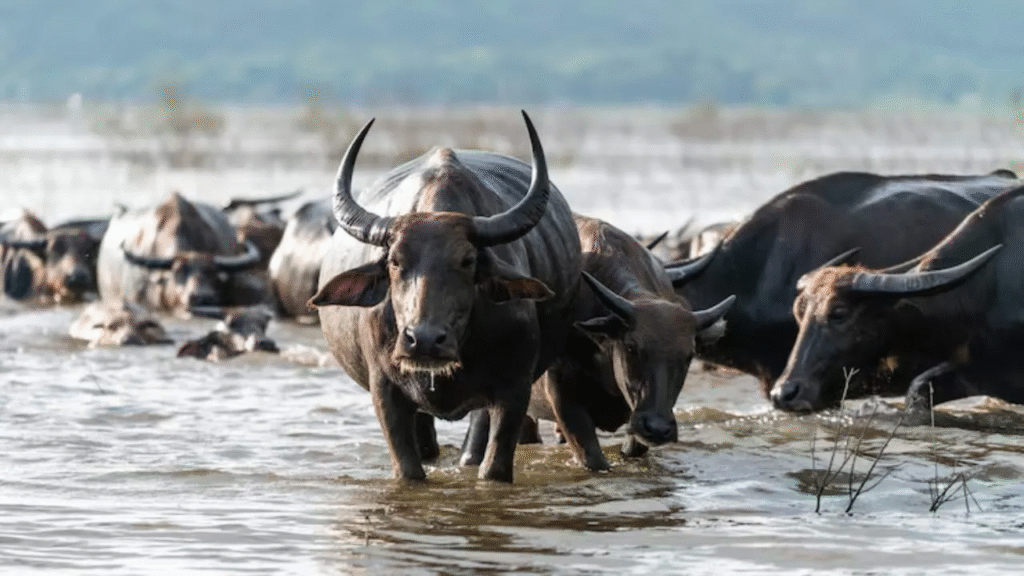
Buffalo cultivating is one of the most productive, and economical agribusiness wanders in India. As the country’s demand for drain, meat, and buffalo leather continues to rise, buffalo have become a crucial contributor to the provincial economy. With the right breed determination, legitimate administration, and effective marketing, buffalo farming can provide a consistent source of income for farmers across India.
Why Buffalo Cultivating is Important
India is the world’s biggest maker of buffalo drain, contributing about 55% of the total drain yield. Buffaloes are profoundly versatile to tropical climates and can flourish indeed in districts with unforgiving climate conditions. Compared to bovines, they require less support and are known for creating drain wealthy in fat and protein — a quality favored by most Indian family units and dairy industries.

Beyond drain, buffalo also contribute to:
Meat Generation: Buffalo meat (carabeef) is one of India’s major export commodities.
Leather Industry: High-quality buffalo hides are utilized in the calfskin merchandise sector.
Draught Control:- In rustic regions buffaloes help in plowing areas and transportation.
Top Buffalo Breeds, in India.
Choosing the right breed is pivotal for maximizing drain abatement and cultivating efficiency. Here are a few of the most prevalent and beneficial buffalo breeds in India:-
Breed Origin Average Drain Abdicate (per day) Special Features.
Murrah Haryana, Punjab 8–18 liters Jet dark, high-fat drain broadly favored for dairy farming.
Nili-Ravi Punjab 10–15 liters Gentle nature, effective drain producer.
Jaffarabadi, Gujarat, 8–12 liters Large body measure, high-fat substance in milk
Surti, Gujarat 6–10 liters Ideal for small-scale ranches, moo maintenance
Mehsana, Gujarat, 7–12 liters Hybrid of Surti and Murrah, great for both drain and draught
Nagpuri Maharashtra 4–8 liters Highly safe to warm and drought
Sambalpuri Odisha 5–8 liters Adaptable to muggy climates
Setting Up a Buffalo Farm
Selecting the Location
Choose a clean, dry region with great seepage and get to new water. The location ought to be near a showcase or drain collection center to decrease transportation costs.
Housing.
Ensure legitimate ventilation, lighting, and drainage.
Maintain 40–50 sq. ft of secured range and 80–100 sq. ft of open space per grown-up buffalo.
Use non-slippery flooring and partitioned sheds for calves, pregnant, and draining buffaloes.
Bolstering and Nutrition
Buffaloes flourish on a blend of:
Green grain: Napier, Berseem, Maize, or Jowar
Dry grub: Wheat straw, paddy straw.
Concentrates: Oil cakes, grains, and mineral mixtures.
Clean water ought to always be accessible, as buffaloes drink 40–60 liters daily.
Breeding
Artificial insemination is favored for quality and control.
Maintain a breeding proportion of 1 bull for each 20 buffaloes.
Ensure opportune discovery of warm cycles and post-calving care.
Wellbeing Management
Regular inoculations (Foot and Mouth Infection, Hemorrhagic Septicemia, Dark Quarter)
Deworming each 3–4 months
Proper cleanliness and infection segregation practices
Initial Speculation and Profit.
Setting up a medium-scale buffalo dairy cultivation (with 10 buffaloes) regularly involves:-
Expense Category Estimated Fetched (₹).
Purchase of 10 Buffaloes 8–10 lakhs.
Shed Construction 2–3 lakhs.
Feed and Feed Setup 1.5–2 lakhs.
Equipment and Machinery 50,000–1 lakh.
Miscellaneous & Labor 1–1.5 lakhs.
Total Investment 13–18 lakhs.
Profit Margin:
With appropriate administration, a rancher can gain ₹50,000–₹1 lakh per month after all costs, depending on drain abdicate, bolster fetched, and advertise price.
Challenges in Buffalo Farming
While productive, buffalo cultivation moreover faces a few challenges:
High bolster fetched fluctuations
Disease flare-ups in unclean environments
Limited access to advanced veterinary services in farther areas
Milk costs are precarious due to advertising variations.
Adopting advanced cultivation methods, biosecurity measures, and government bolster can minimize these risks.
Conclusion
Buffalo cultivating in India is more than a fair conventional occupation, it’s an opportunity for sustainable rural business. With the developing demand for high-quality dairy and meat items, the segment guarantees consistent pay business growth, and regional development. Whether small-scale or commercial, a well-managed buffalo cultivation can yield surprising monetary returns in 2025 and in the past.





